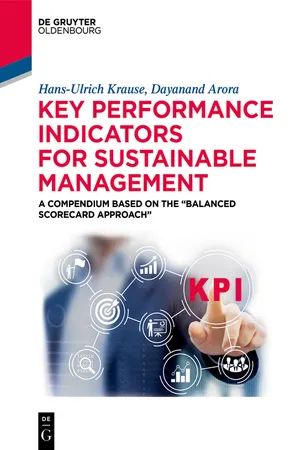Business
Efficiency Calculations
Efficiency calculations in business refer to the process of measuring the output of a business process or activity in relation to the input of resources such as time, money, or materials. This is often done to identify areas for improvement and to optimize performance. Efficiency calculations are essential for businesses to streamline operations and maximize productivity.
Written by Perlego with AI-assistance
Related key terms
1 of 5
3 Key excerpts on "Efficiency Calculations"
- eBook - ePub
Key Performance Indicators for Sustainable Management
A Compendium Based on the "Balanced Scorecard Approach"
- Hans-Ulrich Krause, Dayanand Arora(Authors)
- 2019(Publication Date)
- De Gruyter Oldenbourg(Publisher)
The term “efficiency” and various measures, which are related to or derived from it, are not uniformly defined. Some measures of Efficiency relate to “technical productivity”, whereas other measures relate to “economic productivity”. Mostly, Efficiency is named and described with reference to the input factor, such as material efficiency, labour efficiency (or employee efficiency), energy efficiency, etc.Some examples of efficiency are: production per employee, energy costs per machine hour, sales per square metre of sales area, and contribution margin per client. Various measures of quantity are: units produced, length, area in square meters, weight and time-duration.Output Value (Measured in Monetary Units) Input Value (Measured in Quantity or Monetary Units) The measured efficiency value may be expressed in % (in the case of technical quantity-based efficiency) or in € per square meter, € per client, € per unit, € per hour (in the case of economic/value-based efficiency).Calculation/DerivationThe required data for this quotient is prepared from the internal cost accounting system, which is then processed and made available to decision makers in different cost types, cost-centres, and product costing.Interpretation and Typical RangePut simply, Efficiency is a measure of performance. If it is measured in technical terms, it is similar to productivity and implies the yield of a particular production factor. Since various combinations of production factors (each one measured differently) are used for a particular output, data for measuring efficiency has to be collected and valued for each factor separately. Often the measured value shows partial efficiency.Therefore, it is not easy to recommend a typical range for this ratio. A useful interpretation of this ratio is possible over time, when intra-firm or inter-firm comparisons are made over several periods. When making international comparisons, one has to consider carefully the impact of other value drivers, such as changes in the bilateral exchange rate over time. - eBook - ePub
Operational Excellence
Breakthrough Strategies for Improving Customer Experience and Productivity
- James William Martin, James Martin(Authors)
- 2021(Publication Date)
- Productivity Press(Publisher)
Some organizational cultures execute strategy well, and some do not. In the latter case, there is usually a lack of accountability, and the reward and recognition systems may be broken. There are several organizational attributes that help effectively execute strategy to increase productivity, EVA, ROE, and customer satisfaction. Organizations that have poor strategy execution and alignment to lower-level operational metrics will be hard-pressed to significantly increase productivity, even with excellent project execution. As an example, if marketing's strategic plans are inaccurate, the wrong products or services will be designed, produced, and sold. The processes may be efficient, but products and services will not be sellable at expected margins or perhaps not at all.Calculating Productivity
Organizational productivity is calculated as an efficient utilization of labor, materials, and capital versus the revenue received by their conversion and sale. Productivity is calculated as a ratio of outputs to inputs based on inflation and economic adjustments as shown in Figure 7.1 . It is calculated as a year-to-year index. Pricing adjustments and changes in international currency exchange rates are incorporated into a productivity index for the current year to ensure that, relative to internal operations, production efficiencies are accurately estimated net of the impact of external factors that are beyond an organization's immediate control. Figure 7.1 also shows that higher productivity results from simultaneously increasing sales, lowering costs, or a combination of both. Higher productivity makes an organization more adaptable because it has resources to invest well and a better ability to respond to disruptive changes. It also makes an organization more competitive. High competitiveness enables organizations to dominate their industries.FIGURE 7.1Calculating productivity.There are financial measurements that calculate the effectiveness for increasing sales, reducing costs, and managing assets. These are EVA, NOPAT, market value added (MVA), and ROE. These metrics measure the revenue versus the costs incurred to attain it. Revenue and costs are adjusted for macro-economic factors and estimated using a weighted cost of capital. They will not guarantee that future operational performance will be competitive, but they guide an organization toward improving its operational performance by ensuring resources are allocated to productive activities. The interrelationships between financial and operational performance measurements ensure alignment with available capital to increase revenue, reduce costs, or efficiently utilize assets. - eBook - ePub
Productivity Improvement in Manufacturing SMEs
Application of Work Study
- Thomas Thinandavha Munyai, Boysana Lephoi Mbonyane, Charles Mbohwa(Authors)
- 2017(Publication Date)
- Productivity Press(Publisher)
EOQ involves the number of units that a firm should add to its inventory with each order to minimize the total costs of inventory, such as holding costs, order costs, and shortage costs (Teng, Min, & Pan, 2012:329–33). Ozturk et al. (2015:120–21) consider efficiency as adhering to the required standard working procedure in manufacturing outputs through the appropriate utilization of resources. These resources happen in terms of continuous and batch manufacturing processes in manufacturing SMEs. According to Martínez (2015:325–30), efficiency implies increasing output for a given set of input. However, increasing output with a given set of input involves products manufactured determining the number of workers used, material used, capital used, and amount of energy used, such as electricity.Efficiency in manufacturing, which is also regarded as capacity utilization (Samarajeewa et al., 2012:314–18), involves the extent to which manufacturing industries are using their production potential (also referred to as best use of production factors ) such as employees, material, machinery, capital (money), and energy (Gunasekaran & Spalanzani, 2012:35–45; Karim & Arif-Uz-Zaman, 2013:178–80; Wu et al., 2013:568–78; Bocken et al., 2014:43–54; Roh, Hong, & Min, 2014:198–204; Feiz et al., 2015:283–90; Schulze et al., 2016:3694–3700).Based on the explanations given by the aforementioned authors, the formula for efficiency in manufacturing is presented in the next section. 3.2.4Efficiency Applications According to Uddin (2015:241), the formula for efficiency isEfficiency =However, it needs to be measured for continuous improvement. Thus, one needs to measure efficiency from time to time for improvement. In this case, efficiency is measured against the existing method.Output value Input resource× 100%
Index pages curate the most relevant extracts from our library of academic textbooks. They’ve been created using an in-house natural language model (NLM), each adding context and meaning to key research topics.


